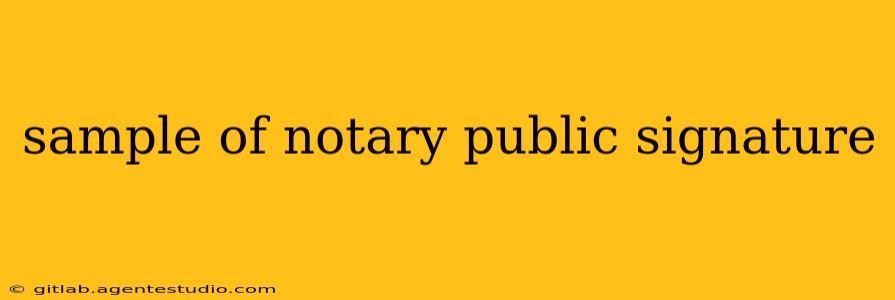Finding a "sample of notary public signature" online might seem helpful, but it's crucial to understand that there's no single, standardized notary public signature. Each notary's signature is unique, just like a handwritten signature for any individual. Searching for a specific example is therefore unlikely to be fruitful and may even be misleading. This article will clarify why and explain what's actually important regarding notary signatures.
Why You Won't Find a Universal "Sample"
The beauty (and the challenge) of a notary's signature lies in its individuality. Notaries are commissioned by their respective states or jurisdictions, and while they must adhere to certain legal requirements in their seal and jurat, the signature itself is a personal mark. It's designed to be unique to prevent forgery and ensure the document's authenticity. This means:
- No two signatures will be identical. Even if two notaries have similar handwriting styles, their signatures will still exhibit subtle differences.
- Samples are not legally binding. A sample found online, even if claimed to be genuine, cannot be used to verify a document's validity.
- Focus should be on the seal and jurat, not the signature alone. The notary's seal, which usually contains the notary's name, commission information, and state seal, is much more important for verification than their signature.
What to Look for Instead of a Sample Signature
Instead of searching for a specific sample, focus on these critical elements when reviewing a notarized document:
1. The Notary Seal:
- Official Seal: The seal must be clearly visible and contain the required information specific to your jurisdiction. This is the primary verification point.
- Legibility: All information on the seal must be easily readable.
- Integrity: The seal should be intact and free from any signs of tampering or alteration.
2. The Jurat or Acknowledgment:
- Correct wording: The jurat or acknowledgment statement must be correctly worded and accurately reflect the nature of the notarization.
- Complete information: The jurat or acknowledgment should include the date of notarization and the notary's signature and seal.
- Consistency: The details in the jurat or acknowledgment should match the information within the document.
3. The Notary's Signature (Contextual Importance):
While not the primary verification point, the notary's signature should appear:
- Consistent: If you have other documents notarized by the same individual, their signature should display a consistent style and characteristics.
- In conjunction with the seal: The signature always accompanies the official seal.
- Legible (to an extent): While individual style varies, it should be possible to determine if the signature on multiple documents is consistent.
How to Verify a Notary's Commission
If you have doubts about the validity of a notarized document, the best approach is to:
- Check the Secretary of State's website: Most jurisdictions offer online databases where you can search for current notaries and verify their commission status.
- Contact the notary directly: If needed, you can contact the notary to confirm their involvement in the notarization.
In summary, focusing on the correct procedures for verifying the official notary seal and jurat is far more effective than seeking a "sample of notary public signature." Remember, the signature itself is unique and its authenticity is confirmed by the complete notarization process, not just the signature alone.

